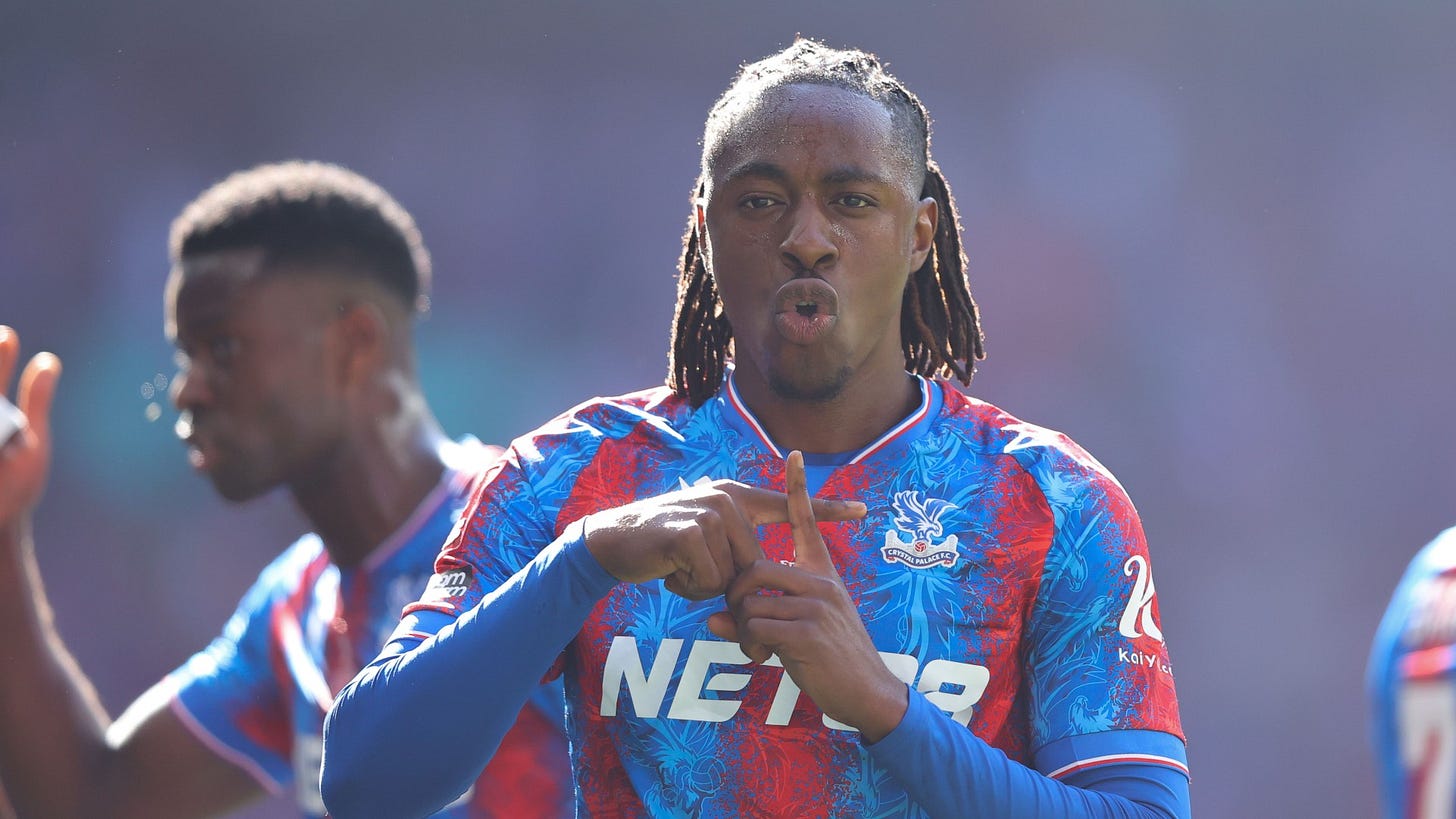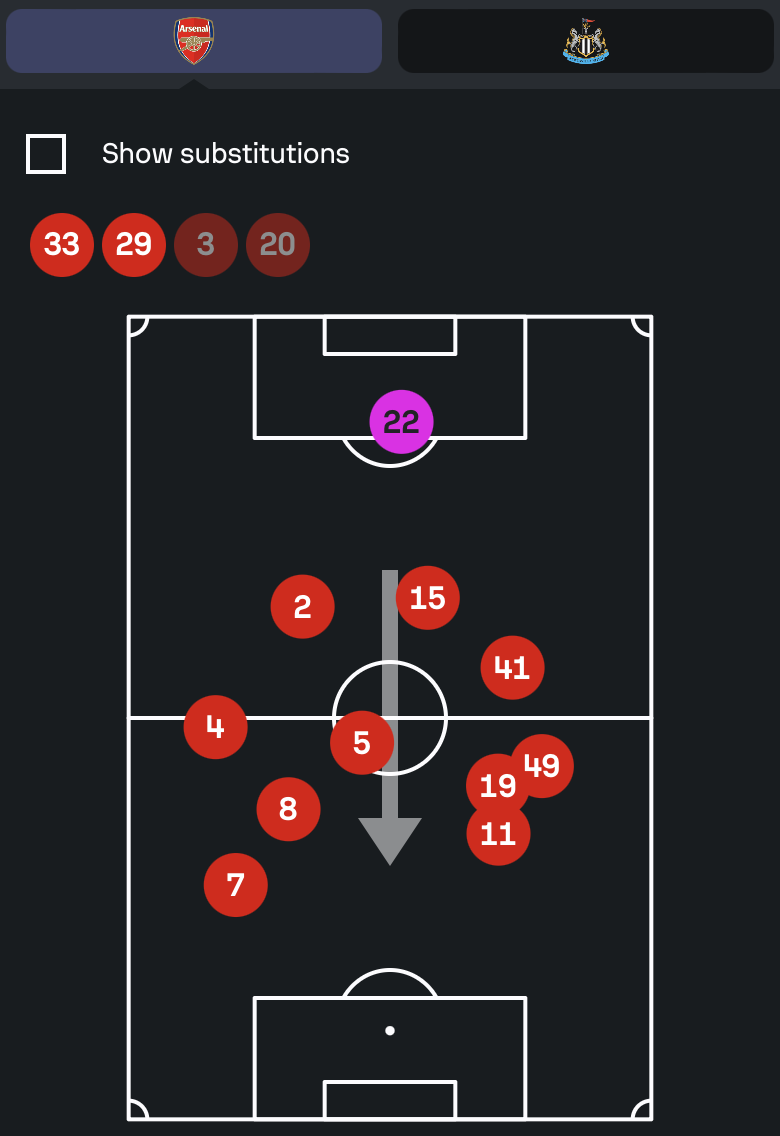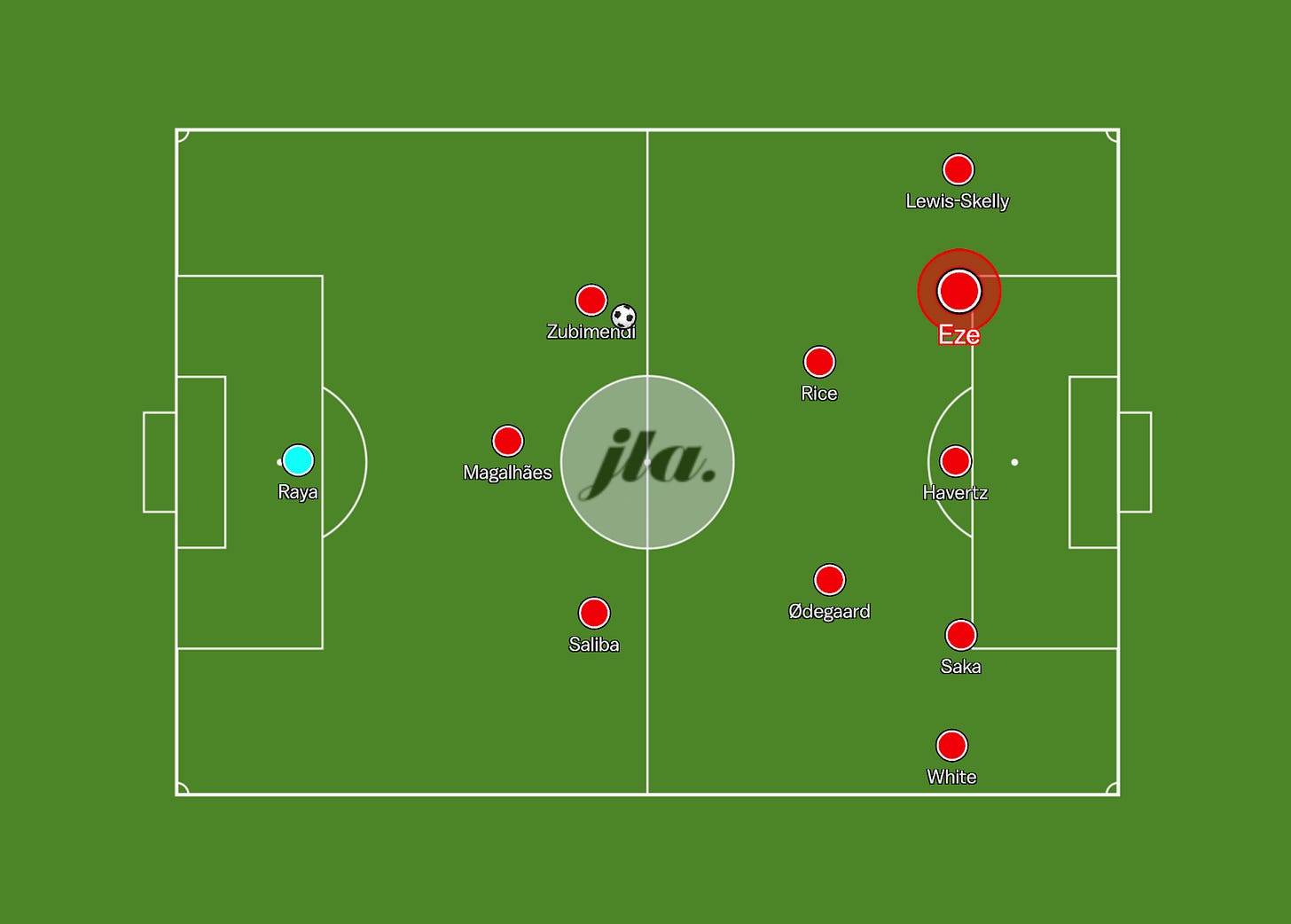Is Eberechi Eze the Perfect Arsenal Signing?
How Eze Fits In At Arsenal
Well, is he? Is Eberechi Eze the perfect signing for Arsenal, possibly taking them even closer to the Premier League title, or finally getting over the line?
What a disarmingly and deceptively simple question! The answer, then: yes or no? The obvious, more reflexive response will respond affirmatively: “How could Eze not improve this Arsenal team - did you not see him against Manchester City in the FA Cup final?”
But we must slow down.
Where will Eze play for Arsenal?
When assessing whether a player is a suitable fit for a team, we must go beyond merely assessing whether the player is or is not a good player; a player may be good but not a good fit for a team. There are manifold examples of this: take Antony’s meme-inducing Premier League form compared to his recent, exciting display in La Liga and the Europa League.
And so, when we assess whether a player is a good match for a team, we must take into account the manager’s system, the style and philosophy of football they play.
This is what we will do here: first, we will assess Eze’s footballing qualities and attributes; second, we’ll examine the new formation that I expect Arteta to implement next season - before concluding whether Eze fits the bill, so to speak.
What Does Eze Provide on the Pitch?
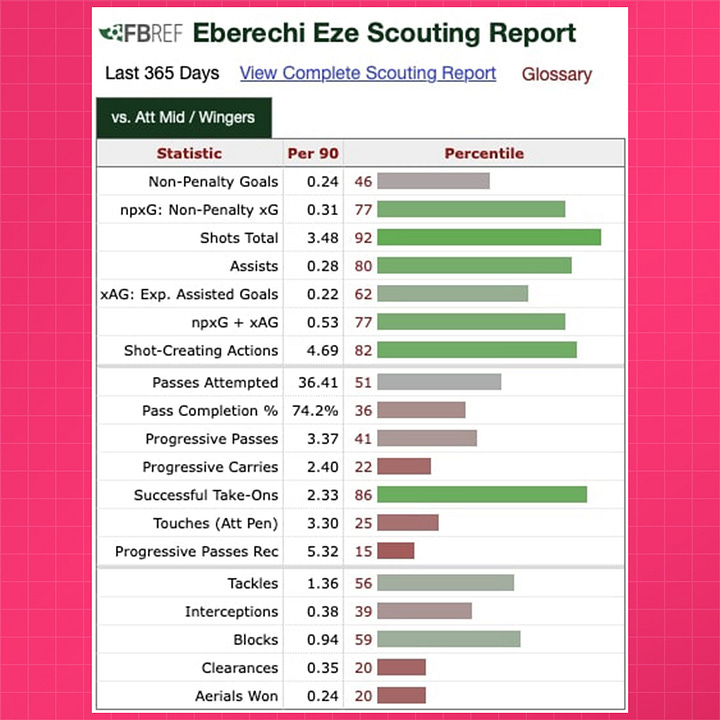
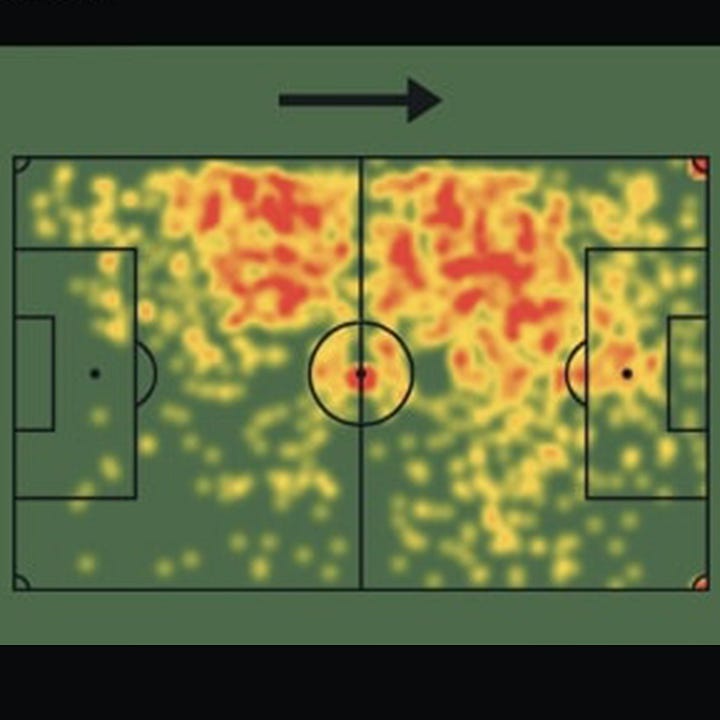
We can gauge an idea of the kind of player he is by looking at his 2024/25 heatmap and FBREF scouting report.
What do these tell us?
The top trisect of the scouting report generally points to Eze’s well-roundedness in the final third. Most particularly, he excels at total shots where he’s in the top 92%, and shot-creating actions of which he ranks in the top 82%. In the middle trisect, there is an obvious standout, he ranks in the top 86% for successful take ons. The statistics, therefore, show us that this is a player who takes a lot of shots, creates a lot of chances for teammates, and seemingly does this through successfully ‘taking-on’ the defender.
Next, the distribution of colour on the heatmap suggests that Eze mainly operates on the left, but not as a traditional winger that hugs the touchline and stretches the play towards the byline; Eze prefers to tuck into the middle of the pitch.
However, despite mainly working on the left flank this year, Eze has also played off the right. Most notably, for QPR, he shifted between the right and left flank, depending on what the team needed.
This presents the profile of a player who possesses the following traits: primarily plays off the left, but can also play off the right; prefers to operate closer to the centre of the pitch by cutting in from the flank; generates a lot of shot-creating actions for himself and for others; and produces chances by beating defenders.
Does this coincide with what Mikel Arteta wants from an attacking player?
Arsenal’s Formation in 2025/26
Going into the new season, it seems likely that Arteta will continue to adapt his style; the final few games of last season gave us an insight into the kind of football Arsenal will most likely play in the 2025/26 season.
Despite Arteta’s extensive (and perhaps gluttonous!) signing of defenders in recent years - partially inspired by Pep’s use, in possession, of a physical and dominant back three made up solely of centre-backs - Arteta now appears to be transitioning away from this, instead preferring a back-3 consisting of two centre-backs and one midfielder.
Take Arsenal’s penultimate game against Newcastle as an example:
Here, we see a makeshift back-3: two centre-backs, Saliba (2) and Kiwior (15), and midfielder Declan Rice (41). The inclusion of Rice may be confusing, but Arteta is using Rice’s ability to progress the ball as a means of moving out of defence, while also providing added defensive security.
This stylistic change has ultimately been forced, motivated by the impressive emergence of Myles Lewis-Skelly and the return from injury of Ben White. Neither full-back fits the mold of the large, physically dominant centre-backs that typically feature in the back-3. Instead, both excel through their athleticism, which is best utilised in progressing the ball in wide areas and creating underlaps and overlaps, adding explosive overloads in attacking wide zones. Using them in a back-3 completely neutralises their strengths. As we can see in the image above, Arteta deploys them wide and high - with White (4) and Lewis-Skelly (49), respectively.
The exclusion of a third natural centre-back in the back-3 forces Arteta to use another player to progress the ball. This is Rice’s role. However, Rice is better utilised further up the pitch, where he can make late runs into the box. Hence, Zubimendi - known for his progressive passing and defensive solidity - will (presumably, in the near future) fulfil this role, thereby freeing Rice.
So far, so good.
But we still haven’t worked out why Eze is needed. Is it merely to replace a recently poor Martinelli? I would gamble and say no - for two reasons.
Firstly, positionally, Eze fits Arteta’s system better than Matinelli.
It’s no secret that Martinelli has not lived up to his potential and ability over the last three seasons. This is due to the change in style of play. Martinelli excels in wide areas, beating players and hitting the by-line. But, as we can see in the image above, this is not where Arteta has been positioning him.
Why? Because the high and wide area Martinelli likes to occupy is now taken by Lewis-Skelly.
Eze doesn’t have this problem. Just look at his last two games (in which he played the majority of minutes):

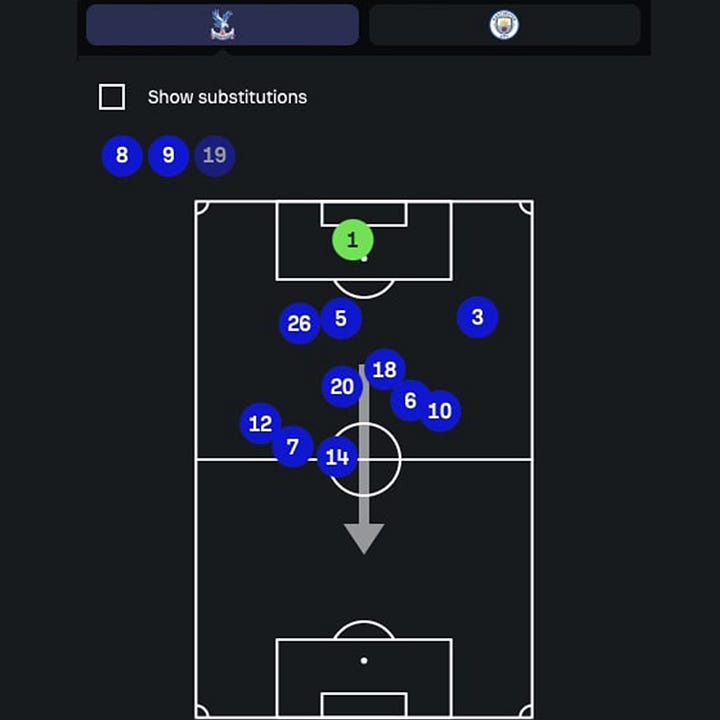
Eze (10) occupies a similar position to where Arteta has recently deployed Martinelli - but unlike Martinelli, Eze is well-suited to playing there effectively. He operates neither as the furthest forward attacker nor as a traditional wide-enabler. Instead, Eze excels in a left-sided inside role, which appears to align perfectly with Arteta’s tactical vision. His presence allows Arteta to fully utilise Lewis-Skelly’s dynamic skillset on the flank.
Secondly, comparatively to their title-pushing rivals, Arsenal are lacking in their ability to create Shot-Creating Actions; see here Arsenal’s ability as a team and Martinelli individually:


Arsenal rank closer to Nottingham Forest than Liverpool, in this metric - the metric that quantifies offensive actions that lead to a shot. Saka and Ødegaard, Arsenal’s creative sparks, rank highly in this metric - but that’s not sufficient; this is a problem that Arteta needs to address because Martinelli is not good enough in this aspect of his game.
Eze, however, as we have soon above in his FBREF Scouting Report, excels in his ability to produce Shot-Creating Actions and would, therefore, help remedy this detriment in Arsenal’s arsenal, if you will.
And so, to conclude: not only does Eze advance Arteta’s newly evolved style, better fitting what Arteta demands from a left winger - but also, provides a creative nous that Arsenal, in 2024/25, severely lacked.
Putting it all together, Arsenal’s setup in 2025/26 will look formidable; on the tactics board, in possession, they will set up in 3-2-5 formation:



